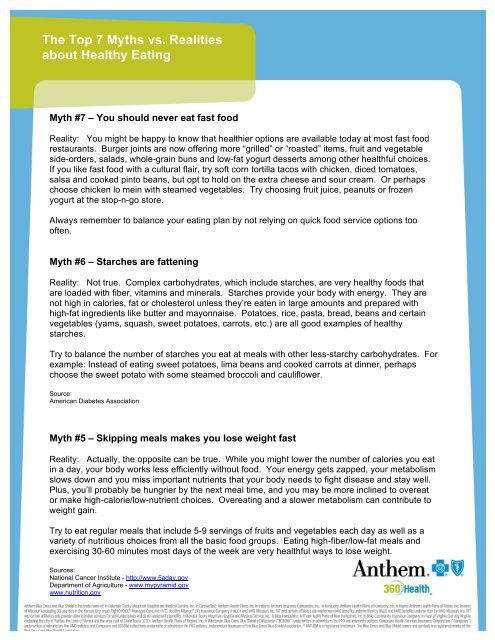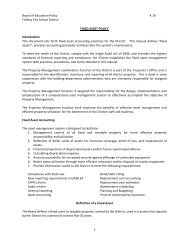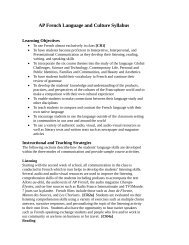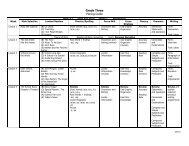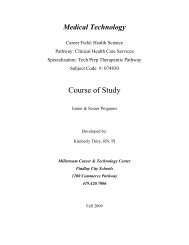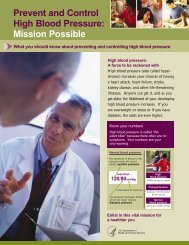The Top 7 Myths vs. Realities about Healthy Eating
The Top 7 Myths vs. Realities about Healthy Eating
The Top 7 Myths vs. Realities about Healthy Eating
Create successful ePaper yourself
Turn your PDF publications into a flip-book with our unique Google optimized e-Paper software.
<strong>The</strong> <strong>Top</strong> 7 <strong>Myths</strong> <strong>vs</strong>. <strong>Realities</strong><br />
<strong>about</strong> <strong>Healthy</strong> <strong>Eating</strong><br />
Myth #7 – You should never eat fast food<br />
Reality: You might be happy to know that healthier options are available today at most fast food<br />
restaurants. Burger joints are now offering more “grilled” or “roasted” items, fruit and vegetable<br />
side-orders, salads, whole-grain buns and low-fat yogurt desserts among other healthful choices.<br />
If you like fast food with a cultural flair, try soft corn tortilla tacos with chicken, diced tomatoes,<br />
salsa and cooked pinto beans, but opt to hold on the extra cheese and sour cream. Or perhaps<br />
choose chicken lo mein with steamed vegetables. Try choosing fruit juice, peanuts or frozen<br />
yogurt at the stop-n-go store.<br />
Always remember to balance your eating plan by not relying on quick food service options too<br />
often.<br />
Myth #6 – Starches are fattening<br />
Reality: Not true. Complex carbohydrates, which include starches, are very healthy foods that<br />
are loaded with fiber, vitamins and minerals. Starches provide your body with energy. <strong>The</strong>y are<br />
not high in calories, fat or cholesterol unless they’re eaten in large amounts and prepared with<br />
high-fat ingredients like butter and mayonnaise. Potatoes, rice, pasta, bread, beans and certain<br />
vegetables (yams, squash, sweet potatoes, carrots, etc.) are all good examples of healthy<br />
starches.<br />
Try to balance the number of starches you eat at meals with other less-starchy carbohydrates. For<br />
example: Instead of eating sweet potatoes, lima beans and cooked carrots at dinner, perhaps<br />
choose the sweet potato with some steamed broccoli and cauliflower.<br />
Source:<br />
American Diabetes Association<br />
Myth #5 – Skipping meals makes you lose weight fast<br />
Reality: Actually, the opposite can be true. While you might lower the number of calories you eat<br />
in a day, your body works less efficiently without food. Your energy gets zapped, your metabolism<br />
slows down and you miss important nutrients that your body needs to fight disease and stay well.<br />
Plus, you’ll probably be hungrier by the next meal time, and you may be more inclined to overeat<br />
or make high-calorie/low-nutrient choices. Overeating and a slower metabolism can contribute to<br />
weight gain.<br />
Try to eat regular meals that include 5-9 servings of fruits and vegetables each day as well as a<br />
variety of nutritious choices from all the basic food groups. <strong>Eating</strong> high-fiber/low-fat meals and<br />
exercising 30-60 minutes most days of the week are very healthful ways to lose weight.<br />
Sources:<br />
National Cancer Institute - http://www.5aday.gov<br />
Department of Agriculture - www.mypyramid.gov<br />
www.nutrition.gov
Myth #4 – If you work out, you can eat whatever you want<br />
Reality: Hold on there, champ! <strong>Eating</strong> plans can certainly differ based on how active<br />
you are and how intense your work out is. Professional athletes and construction<br />
workers pack a tremendous amount of physical activity into a day; but that doesn’t mean<br />
they get to super-size any food they want. It means that their calorie requirements might<br />
be a little higher than for people who get only low-to-moderate levels of physical activity<br />
each day. To stay lean and healthy, it’s best to choose the most nutrient-rich foods from<br />
the basic food groups every day, eat them in the right portions, and stay active.<br />
Myth #3 – What you eat matters more than how much<br />
Reality: Partially true. What you eat is just as important as how much you eat, how<br />
often you eat it and how you prepare it. Cheese is a great dairy food. But eating too<br />
much of it can add extra calories, fat, sodium and cholesterol. A healthy eating plan<br />
doesn’t mean you have to eat like a rabbit. Choose a variety of nutritious foods every<br />
day. And enjoy your favorite treat once in a while in sensible portions.<br />
Myth #2 – You have to lose a lot of weight to make a difference<br />
Reality: Not true. Moderate weight loss can be very beneficial to your overall health.<br />
Studies have shown that losing 5-10% of your weight and keeping it off can help reduce<br />
blood pressure and cut your risk of heart disease and some cancers.<br />
Myth #1 – Desserts are forbidden<br />
Reality: Correction: Desserts are allowed! Try healthful choices like fruit salads, low-fat<br />
yogurt with fruit, sorbets, frozen fruit juice bars, angel food cake, and frozen yogurt.<br />
Source:<br />
Reader’s Digest (online) – “7 Diet Misconceptions” -<br />
http://www.rd.com/healthy-living/health/weight-loss-7-diet-misconceptions/article.html<br />
This information is intended for educational purposes only, and should not be interpreted as medical advice. Please<br />
consult your physician for advice <strong>about</strong> changes that may affect your health.


